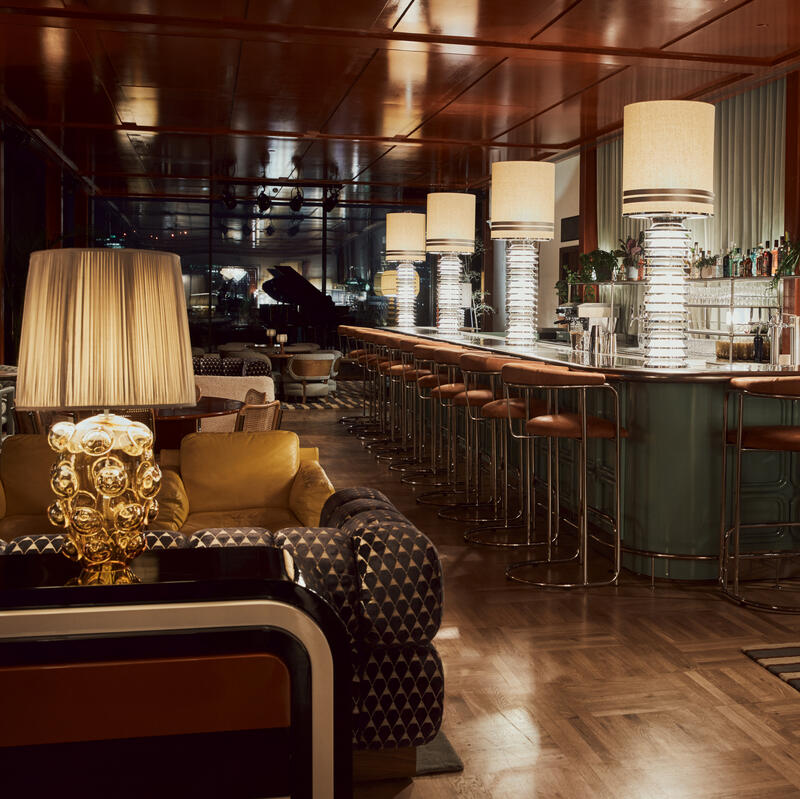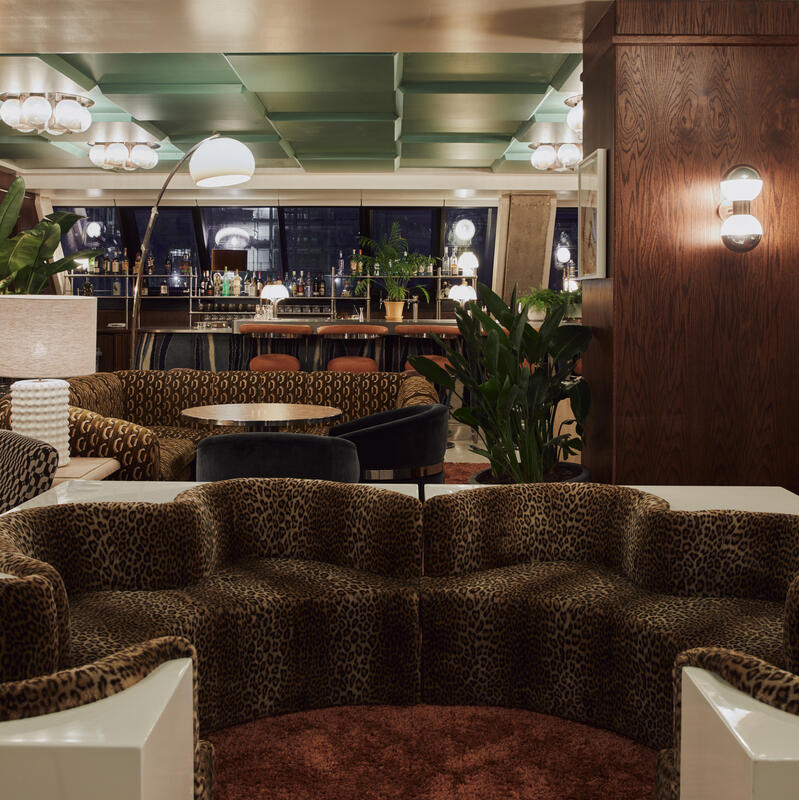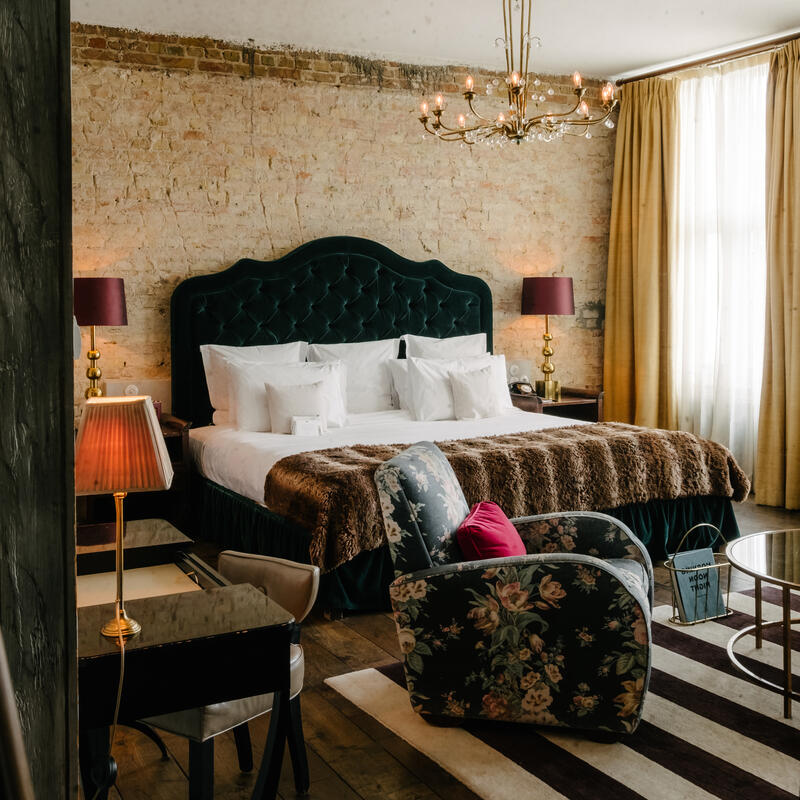Since the very first Soho House on Greek Street in London, the inimitable aesthetic of our clubs has been at the heart of our members' experience. While each interiors concept is original from site to site, there are some archetypal themes that you'll always see coming through, such as bold design choices and contrasting fabrics and furnishings, alongside unique vintage pieces and a curated selection of artworks.
Between our lighting schemes and layering techniques, these sensibilities are present not only in the Houses, but also in our Soho Home collections and interior design service. Informed by 25 years of experience and underpinned by our members, these core design pillars are what gives the Houses their unique feel. Read on, as our Soho House Design team shares how these principles shape the clubs.


History and locality
Every Soho House tells a story, that's what makes it unique. It starts with the original architecture and purpose of the building, as well as the design identity of the community, from time-honoured crafts to materials that the country of each location is known for. 'The existing site is our biggest form of inspiration and we'll learn everything we can before arriving. Then, we'll visit every few months, walk the streets, and get to know the locals and the stores nearby,' explains Candace Hickman, Soho House Design Lead Designer.
After working with our Cities Without Houses team to get a personal perspective, the designers create a connection to the location by embracing its native materials. 'Italy does stone really well, and so across Soho House Rome you'll find travertine flooring and Verde Guatemala marble in the bathrooms, all sourced locally. The outdoor seating was also developed by Italian fabric suppliers, and tapestry artists created woven pieces for the bedrooms,' says Domhnall Nolan, Soho House Design Senior Designer.
Alongside representing the location as it is today, the team also delves into the past for inspiration. 'We like to do the unexpected, and you'll find this theme running through all of our design decisions,' says Hickman. 'I prefer to find stories that don't fit the obvious picture of the building. At Soho Warehouse, we leaned into the industrial vibe, leaving brickwork exposed and highlighting graffiti that had built up. But, after discovering it had been live-in recording studios for the Red Hot Chili Peppers, we used vintage furniture from the 1960s to layer in that story, which contrasted with the harder features.'


Building an identity
Candy Murray, Soho Home Interior Style Manager, uses this storytelling approach to help her interior design service clients build a narrative in their space. 'Even if your home doesn't have "wow" architecture, there are ways to tell its story by using its existing features, highlighting the rooms you'll spend the most time in and taking cues from furniture or art you already have to let this define the scheme,' she says.
Vintage style is a great way to add a sense of personality; a technique that all of our Houses use. To do this in your home, Murray suggests honing in on pieces from local markets or from the same era as your building to make that connection. 'This will create a sense of authenticity, with reclaimed materials and pre-loved pieces bringing a lived-in feel,' she says. 'I also like the idea of telling your own story through vintage - maybe it's the way an item shone out to you, or that you liked learning about a particular era. Choosing homeware that means something to you stops a space looking clinical.'


Design rooted in comfort
In many ways, the Soho House look has become one of the things we're most known for, but underneath every aesthetic decision is practicality, comfort and a tested member experience. Founder Nick Jones's eye for design is what started the House's iconic style, but his belief is that if it doesn't 100% work, it's out. No sofa is left untested (i.e. laid upon), and every moment of the member's journey around a House has been walked again and again.
Across every project, you'll see that our design is rooted in comfort and there are core techniques that have become consistent staples. For example, our bedrooms have an accent chair or bench, so that there's somewhere to take your shoes off after a long day. Lighting is controlled by a single bedside switch, meaning you don't have to get up when it's time to sleep. In our lounge spaces, there are more cushions than you'd expect for extra back support, a warm throw is never far away, and seats with extra depth are chosen for added comfort.
Murray uses the same techniques to build a brief on what Soho Home interior design clients need from each room. 'We consider the use of each space, asking questions around where they eat, entertain, relax after work, and what that looks like. Then, we can work out little touches to make their lives easier,' she says.
'There are so many things you can take from Soho House and apply to your own home. For example, overhead lighting always sits directly over the bed, so that when you're looking up the fixture isn't off-centre, and reading nooks should be created wherever your afternoon light falls.'


Creating depth with contrasting layers
Layering is a huge part of the Soho House approach to design across all of our pillars. 'If I had to choose one word to describe our style, it would be eclectic,' says Murray. 'Members think of us for the experimental mix of patterns, fabrics and colours seen in our clubs, used in a daring way that you won't find anywhere else. A great example of this is Soho Farmhouse, because while the overarching aesthetic looks unified, it's made up of so many influences.'
'Navajo prints sit next to soft florals and classic stripes, and furniture has been custom made in modern shapes, mixed with rustic farmhouse pieces. What keeps it all together is a sense of consistency in the earthy colour palette, which is key when layering,' she explains. Put simply, Murray advises aiming for juxtaposition: 'Whether it's seating or lighting, keep mixing so as not to look themed - I love a glass sconce next to a cotton shade, or a leather chair by a linen sofa.'
When working with Soho Home clients, Murray optimises accessories to bring patterns into the space. 'Lampshades, cushions and footstools are the best way to start. Choose patterns in varying scales and from different eras, but in complementary colours. You can't go wrong with a printed rug for an extra layer, plus a marble table, which adds timeless depth,' she says.
Hickman says that shape is also an important part of creating an eclectic look. 'We use different styles together all the time,' she says. 'Try this at home: pick two vintage chairs from one set, and mix with four from another. The shapes should be different, but perhaps the wood tone or upholstery is similar.'


Layered lighting
Our multi-layered lighting scheme has become something of a perfect science for our design team, who use light sources at different heights to create a holistic glow. 'Lighting brings emotion into a space,' says Hickman. 'You can have the most beautiful interiors concept, but without the right mood it falls flat.'
According to Hickman, the first step is assessing the light you already have: 'We place seating by big windows so that members get the best of the natural light.' Then, to build your own tiered lighting scheme at home, start with at least three table lamps in the space, either on bedside tables, or side and console tables in a living room. Next, add a floor lamp in a corner or behind an occasional chair - curved shapes like Soho Home's Arc, Rowan or Parker styles are particularly good for bringing the scheme together. And while wall sconces can be overlooked, we position them at equal heights to add the next layer of lighting.
Finally, your ceiling fixture should never be the main source of light; instead, choose something that will make a statement. 'Chandeliers are great, or use two overhead lights to zone an open-plan living space - something high and wide for the lounge, and a low pendant over the dining table,' she adds.
Murray's top lighting take-away tip? 'Put every light source on a dimmer, and always go a little darker than you think,' she says.


Hero a statement piece
From choosing locations that you wouldn't expect - Shoreditch, for example, wasn't the buzzing hub it is now when we opened in 2007 - to creating contrast in the face of the obvious, such as the velvet pink interiors in Berlin's sprawling warehouse, we like to make a statement.
'I believe every room needs that wow moment,' says Nolan. 'We look at it as a hierarchy of design: decide on the must-have features you can't live without or those that will spark a conversation - like the leopard print seating at 180 House,' he continues. 'The print isn't what you'd expect from Soho House. It's divisive - some people love it and others don't get it at all, but either way it's something they'll remember. The balance is that you can't do that everywhere, so choose your features and those that complement it.'
Throughout the Houses, there's one furniture piece you'll see making a statement again and again: the accent chair. They are positioned - often in pairs - in bedrooms, walk-throughs and in corners all over the Houses as a recognisable Soho House Design stamp.
'This is probably the simplest and most Soho House way of creating that standout moment in your home. Search for a vintage or patterned accent chair that doesn't match the space at all - have fun with it, such as choosing an interesting shape. Position it on its own; it doesn't need to be built into the wider scheme and you can move it anytime,' says Nolan.



















